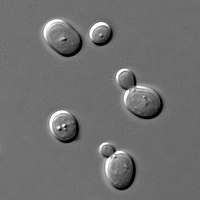
Photo from wikipedia
Abstract Large volumes of anaerobic digestion effluents (ADEs) are generated by intense livestock and poultry farm activities. If untreated, these effluents represent a threat to the environment. Previous data have… Click to show full abstract
Abstract Large volumes of anaerobic digestion effluents (ADEs) are generated by intense livestock and poultry farm activities. If untreated, these effluents represent a threat to the environment. Previous data have indicated that microalgae are able to grow in photobioreactors (PBR) where high concentrations of inorganic salts are present. In the present research, algae-assisted sequencing batch photo-bio-reactor (A-SBPBR) with single micro-algae systems and single activated sludge systems were developed. We studied the effects of the treatments on different parameters including COD, TN, AN, and TP. We analyzed changes in bacterial community diversity using the high-throughput sequencing analysis. The degradation mechanism of the ADEs was studied by means of algal-bacterial symbiosis. Experimental results indicated that contaminants were efficiently removed from the ADEs when using the A-SBPBR. After treatment, the degradation rates of COD, TN, AN, and TP were 73.78%, 80.67%, 89.74%, and 95.39%, respectively. The outlet concentrations of COD, TN, AN, and TP were 355.09 ± 17.90, 83.97 ± 9.37, 35.42 ± 2.65 and 0.87 ± 29 mg/L, respectively. In the initial stage of the process (day 1), the most abundant bacteria present in the ABS (algal-bacterial symbiosis system) included proteobacteria, bacteroidetes, actinobacteria, acidobacteria and chloroflexi. Among these, those with the highest abundance values were proteobacteria and bacteroidetes. Abundance values were 24.33% and 19.97%, respectively. A-SBPBR contained various microorganisms including aerobic bacteria, fungus, and chlorella. In a reciprocal interaction, bacteria and microalgae were able to use each other´s metabolites. Under intermittent aeration conditions, organic C, N, and P present in the macromolecules were converted to smaller species. C was transformed to CO2 and organic C. In addition, N and P stayed as part of small molecules that were used by aerobic bacteria and fungus. When ABS operation reached stability, hydrolytic acidifying bacteria, which belonged to acidobacteria, were able to degrade different organic compounds including saccharides.
Journal Title: Agricultural Water Management
Year Published: 2021
Link to full text (if available)
Share on Social Media: Sign Up to like & get
recommendations!